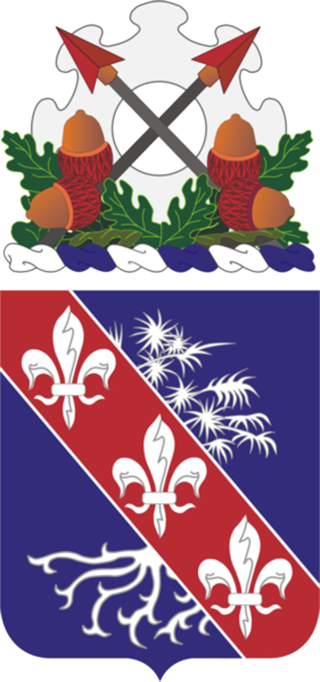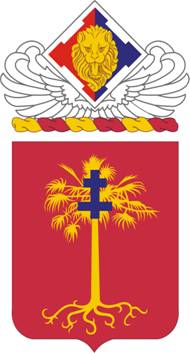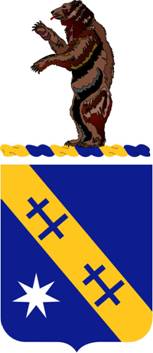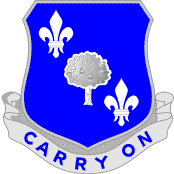
The 78th Training Division (Operations) ("Lightning") is a unit of the United States Army which served in World War I and World War II as the 78th Infantry Division, and currently trains and evaluates units of the United States Army Reserve for deployment.

The 77th Sustainment Brigade is a unit of the United States Army that inherited the lineage of the 77th Infantry Division, which served in World War I and World War II. Its headquarters has been at Fort Dix, New Jersey, since its predecessor command, the 77th Regional Readiness Command, was disestablished in 2008 from Fort Totten in Bayside, Queens, New York. Soldiers from the 77th have served in most major conflict and contingency operations since World War II.

Julius Ochs Adler was an American publisher, journalist, and highly decorated United States Army officer with the rank of major general. He distinguished himself during World War I as Major and battalion commander in the 306th Infantry Regiment and received Distinguished Service Cross, the second highest decorations of the United States military for valor in combat.

Charles White Whittlesey was a United States Army Medal of Honor recipient who led the Lost Battalion in the Meuse–Argonne offensive during World War I. He committed suicide by drowning when he jumped from a ship en route to Havana on November 26, 1921, at age 37.

The 327th Infantry Regiment is an infantry regiment of the 101st Airborne Division of the United States Army. During World War II, the 327th was a glider-borne regiment of the 101st Airborne Division. It fought during World War I as part of the 82nd Division. It has also been deployed in the Vietnam War, Gulf War, and most recently to Iraq and Afghanistan. The song "Glider Rider" describes (humorously) some of the slights that glider-borne troops felt they received from the Army during World War II; though the regiment's public fame rose with the 1949 movie Battleground about the Siege of Bastogne in late 1944.
The 54th Infantry Regiment is a United States Army Regimental System parent regiment of the United States Army. It is represented in the active Army by the 2nd and 3rd Battalions, which conduct Infantry One Station Unit Training (OSUT) at Fort Moore, Georgia.
George Gibson McMurtry was a United States Army officer, a Medal of Honor recipient and a Harvard–educated Wall Street lawyer.

The 157th Infantry Brigade is an active/reserve component (AC/RC) unit based at Camp Atterbury, Indiana. The unit is responsible for training selected United States Army Reserve and National Guard units. The unit was activated using the assets of the 5th Brigade, 87th Division. The brigade is a subordinate unit of First Army Division East.
The 314th Infantry Regiment is an infantry regiment of the U.S. Army first organized in 1917.

The 39th Infantry Division was an infantry formation of the Army National Guard, originally formed as the 18th Division in 1917. The division consisted of troops from Arkansas, Louisiana, and Mississippi. After training at Camp Beauregard, Louisiana, the division was deployed to France but did not see combat before the end of World War I. In July 1923 the division was re-designated as the 31st Infantry Division. The 39th Infantry Division was reactivated after World War II with troops from Louisiana and Arkansas and its headquarters in Louisiana. In 1967, the 39th Infantry Division was reorganized to become the 39th Infantry Brigade (Separate). Its headquarters was in Little Rock and the unit consisted entirely of troops from Arkansas.

The Lost Battalion is the name given to the nine companies of the US 77th Division, roughly 554 men, isolated by German forces during World War I after an American attack in the Argonne Forest in October 1918. Roughly 197 were killed in action and approximately 150 missing or taken prisoner before the 194 remaining men were rescued. They were led by Major Charles W. Whittlesey. On 2 October, the 77th division launched an attack into the Argonne, under the belief that French forces were supporting their left flank and two American units including the 92nd Infantry Division were supporting their right. Within the 77th sector, some units, including Whittlesey's 308th Infantry, were making significant headway. Unknown to Whittlesey's unit, the units to their left and right had been stalled. Without this knowledge, the units that would become known as the Lost Battalion moved beyond the rest of the Allied line and found themselves surrounded by German forces. For the next six days, suffering heavy losses, the men of the Lost Battalion and the American units desperate to relieve them would fight an intense battle in the Argonne Forest.
The 304th Infantry Regiment currently consists of two battalions in the United States Army Reserve. In the current organizational plan of the U.S. Army, regimental designation is used only in historical tradition; there is no regimental commander, staff or headquarters. The 1st Battalion, 304th Regiment is headquartered in Londonderry, New Hampshire, and the 3rd Battalion, 304th Regiment is headquartered in Saco, Maine.

The 320th Field Artillery Regiment is a field artillery regiment of the United States Army. A parent regiment under the U.S. Army Regimental System, the 320th FAR currently has two active elements in the 101st Airborne Division : 1st Battalion, 320th FAR "Top Guns" in 2nd Brigade Combat Team; and 3rd Battalion, 320th FAR "Red Knight Rakkasans" in 3rd Brigade Combat Team. The regiment served with the 82nd Airborne Division during World Wars I and II, and regimental elements have served with the 82nd and 101st Airborne Division, the 193rd Infantry Brigade and the Berlin Brigade, and conducted combat operations in the Dominican Republic, Vietnam, Grenada, Operations Desert Shield and Storm, and the Global War on Terror.

The 324th Infantry Regiment was an infantry regiment of the United States Army first organized in August 1917 as part of the 81st Division, National Army. The 324th Infantry saw combat in the defense of the St. Die sector of Lorraine, and later took part in the closing stages of the Meuse-Argonne offensive of the First World War. The 324th Infantry was demobilized in June 1919, and subsequently reconstituted in the Organized Reserves in 1921, as part of the 81st Division. In 1942, the 324th Infantry was relieved from assignment to the 81st Division, allotted to the Army of the United States, and assigned to the 44th Infantry Division, a unit which fought as part of the 7th Army in France and Germany during World War II.
The 307th Infantry Regiment was a National Army unit first organized for service in World War I as part of the 77th Division in France. It later served in the Pacific Theater during World War II. Since then it has served as a training Regiment. In 1999, it was withdrawn from the Combat Arms Regimental System and redesignated as a non-branch regiment. The regiment's 1st Battalion is assigned to the 174th Infantry Brigade at Joint Base McGuire–Dix–Lakehurst, New Jersey, with the 2nd Battalion is assigned to the 157th Infantry Brigade at Camp Atterbury, Indiana.

The 140th Infantry Regiment was an infantry formation of the Missouri National Guard.
The 306th Infantry Regiment was a National Army unit first organized for service in World War I as part of the 77th Infantry Division in Europe. It later served in the Pacific Theater during World War II. Since then it has served as a training Regiment. In 1999, it was withdrawn from the Combat Arms Regimental System and redesignated as a non-branch regiment. The regiment's 1st, 2nd, 4th, and 5th battalions are stationed at Fort Stewart under the command of the 188th Infantry Brigade. The 3rd Battalion is inactive.

The 310th Infantry Regiment was a National Army Infantry Regiment first organized for service in World War I as part of the 78th Division. It later served in the European Theater during World War II. Since then it has served as a training Regiment, training Army Reserve and Army National Guard soldiers for service after the September 11 terrorist attacks.
The 305th Infantry Regiment was a National Army unit first organized for service in World War I as part of the 77th Infantry Division in Europe. It later served in the Pacific Theater during World War II. Since then it has served as a training Regiment. In 1999, it was withdrawn from the Combat Arms Regimental System and redesignated as a non-branch regiment. The regiment's 1st and 2nd battalions are stationed at Camp Shelby under the command of the 177th Armored Brigade. The regiment's 3rd battalion is inactive.

The 359th Infantry Regiment is a unit of the United States Army. It was active in Europe as part of the 90th Infantry Division during World War I and World War II, and components of the regiment were later part of the United States Army Reserve.













